
A Breakthrough in Measuring Empathy with AI
The ability to empathize has long been an essential aspect of human interaction, allowing individuals to connect and understand each other's emotional experiences. Psychologists have traditionally utilized self-reported frameworks, such as the Empathy Quotient (EQ) and the Toronto Empathy Questionnaire (TEQ), to gauge these feelings. However, new advancements at Hong Kong Polytechnic University propose a shift towards a more objective and quantifiable method: an innovative machine learning-based framework for analyzing empathy from video footage.
Understanding the New Machine Learning Framework
This novel approach leverages video analysis to predict empathy based on observable behaviors during interactions. Researchers, including Li Cui and his team, have developed this framework using real-world footage, such as interviews between CEOs and TV journalists. This innovative model holds promise, particularly in organizational psychology, where understanding empathy can help shape corporate policies and enhance workplace dynamics.
The Role of AI in the Emotional Landscape
With the rise of artificial intelligence, our understanding of interpersonal communications is entering a new era. According to Cui, as AI takes over analytical tasks, human roles increasingly revolve around emotional connection and support. In this evolving landscape, the measurement of empathy becomes vital. Unlike prior methods, which have been criticized for their indirect nature, this AI-powered video analytics framework facilitates direct observation and analysis, potentially transforming how we understand and prioritize empathy in various contexts.
Empathy Matters in the Corporate World
Why is empathy particularly important in professional settings? The findings from this framework suggested that leaders who possess higher empathy not only connect better with their teams but also can impact the overall value of their organizations. By understanding emotions through analyzed conversations, businesses can make informed decisions that foster healthier workplace environments. This is seen as a more holistic approach, shedding light on the importance of emotional intelligence amidst traditional focuses on negative traits in leadership.
Implications and Future Predictions
The implications of this research are significant, especially as organizations strive for more inclusive corporate climates. As companies begin to recognize the value of empathy for productivity and employee satisfaction, the integration of such analytics into hiring practices and leadership development programs could become standard. This evolution presents an exciting opportunity, positioning empathy not as a soft skill but as a quantifiable asset in business strategy.
Challenges and Ethical Considerations
Despite the promises of this new AI framework, there are challenges that accompany its implementation. Ethical considerations surrounding privacy and the potential misuse of video analytics must be addressed to ensure that this technology does not infringe on personal rights. As organizations begin employing these tools, they must also foster a culture of trust and transparency, utilizing the insights gained for the betterment of employee relations rather than manipulation.
In conclusion, the emergence of AI-driven tools for measuring empathy represents a significant step forward in understanding human relationships and improving workplace dynamics. By shifting focus from purely self-reported metrics to observable behaviors, this research highlights the pivotal role that empathy can play not just in interpersonal connections, but in the success of organizations at large.
 Add Row
Add Row  Add
Add 




Write A Comment